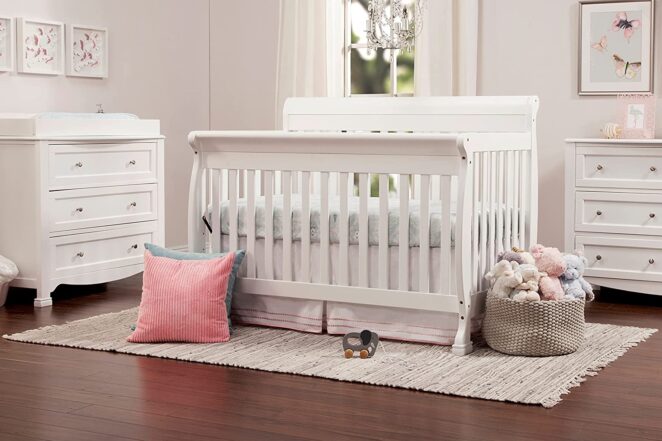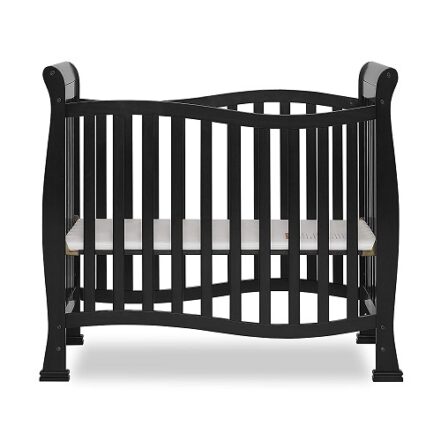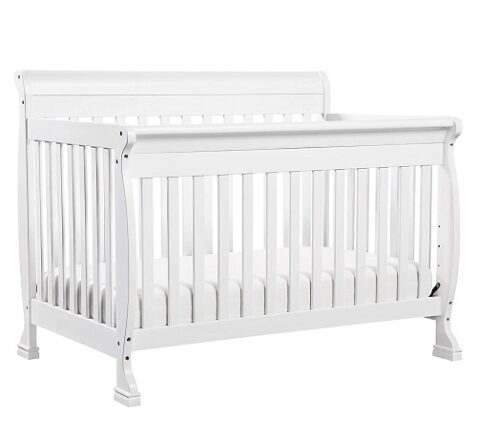Your baby’s bed is the first and most essential item to have in their nursery. This article is a review of comparisons of mini cribs and standard cribs. However, comparison between the two doesn’t imply that one is better than the other; it only serves to help you make an informed choice on the most suitable for your needs.
The main difference between a mini crib and a standard crib is size. Mini cribs are smaller versions of regular cribs (full-sized cribs). Your choice to have a mini crib or a full-sized crib will depend on the space in your nursery and your budget, among other factors.
What Is a Mini Crib?
A mini crib is a baby’s bed that is smaller than a standard crib. Mini cribs vary in size, but the average is 24 x 38 inches. Mini cribs are most suitable for babies below two years.
Mini cribs are sometimes known as portable cribs. Most mini cribs are usually foldable, portable, and cheaper than full-sized cribs. Some also have wheels to ease their transportation from one room to another.
Pros and cons of mini cribs
Pros
Fit for small spaces
A mini crib is convenient when your nursery is small or has other furniture, leaving little space. A mini crib is also suitable for placing two cribs in a room for twins or placing a crib in an older kid’s room.
Best for travel
Most mini cribs are foldable, lightweight, and portable, making them convenient for travel. For instance, you can carry a mini crib for your baby to use at his grandparents’ house. Some have wheels to ease movement from one room to another.
Best for newborns
A mini crib is the best and safest place for your baby to sleep from birth up to about 45 lbs (less than two years).
Best for budget
A mini crib is a better option when working with a limited budget, it being generally cheaper to buy than a standard crib. You can also find a convertible mini crib that you can transform into a toddler bed when your baby grows bigger; this will save you the cost of buying a regular crib.
Easy to store and assemble
A mini crib folds easily, thus becoming easy to store and occupying little storage space. A mini crib is also easy to assemble; you can do it without help. You can also convert the mini crib into a playpen by removing its legs.
Cons
Your baby will outgrow the mini crib soon, and you’ll need to buy a full-size crib.
Mini cribs come in various sizes and shapes. Since standard crib mattresses don’t fit mini cribs, finding fitting sheets and other bedding can be more difficult.
Best Mini Crib
Dream On Me Violet Mini Crib
Design
The mini crib has a minimalist, flowing design making it perfect for compact spaces. It is made of pinewood and is available in six lovely finishes and designs.
The Violet Mini Crib is a 4-in-1 convertible mini crib that grows with your little one. Using bedrails (sold separately), you can convert the mini crib into a mini daybed and twin bed.
Safety
The mini crib prioritizes safety; it is JPMA certified and does not emit lead or other toxic elements. It measures 42L x 25W x 36H and is a suitable toddler bed for children below 50 lbs.
Crib Mattress
The Violet Mini Crib has a three-position height adjustable mattress for adaptability and with a one-inch mattress pad. Choose a Greenguard Gold Certified mini crib mattress for an excellent fit. All tools and assembly instructions are provided.
What Is a Standard Crib?
A standard crib (regular crib) observes standard dimensions set by law with slight variations of about ¼ of an inch depending on the brand and model. Thus, a full-size crib usually is 52 inches long and 28 inches wide. From the mattress, the crib rail should be 20 inches high, and the mattress support should be 6 inches off the ground.
Standard cribs may have shelves and compartments; they may come in different styles but are not portable. Most regular cribs convert to toddler beds and later kid beds, so they’ll stay with you longer.
Pros and cons of standard cribs
Pros
- Standard cribs must meet strict safety criteria, so you’re sure that your baby is safe in them.
- Full-size cribs are more advanced in storage features than mini cribs. For example, they may have attached dressing tables, shelves, or drawers with enough space for your baby’s items.
- Since full-size cribs are standardized, getting a crib mattress is easier as they all fit.
- You can transform a full-size, convertible crib into a full-size bed as your little one grows, saving you the need to buy another bed for them.
- Full-size cribs are large and very sturdy; they are durable and accommodate heavy toddlers or kids. They are most suitable for two-year-olds and older kids.
Cons
- Due to their large size, full-size cribs require more space than mini cribs.
- Full-size cribs are more expensive than mini cribs.
- A standard crib is not foldable or portable; you’ll have to buy a mini crib in case you need to travel.
- A full-sized crib is challenging to assemble due to its weight.
Best Full-Size Crib
DaVinci Kalani 4-in-1 Convertible Crib
Certification
The 4-in-1 convertible crib is Greenguard Gold Certified. It has undergone thorough scientific testing for numerous chemical emissions and VOCs and has proven to emit none. Thus, the crib creates a healthy environment where your baby can play, sleep and grow.
Since it’s a regular crib, it can fit any standard crib mattress, but its manufacturer recommends DaVinci’s Greenguard Gold mattresses.
Conversion
With four adjustable mattress positions, the crib can convert into a daybed, toddler bed, and full-size bed using conversion kits sold separately.
Safety and Quality
The crib’s multi-step painting process is non-toxic, lead, and phthalate-free, so your baby will never breathe toxic chemicals. In addition, the crib is made of New Zealand pine wood which is 100% sustainable – the best quality for your lovely baby.
Complimentary
You can buy Kalani three-drawer and six-drawer dressers to complement your crib’s look.
Measurement and Weight Limit
The inner dimensions of the crib are 52.1 x 28.1 inches, while the front-rail top to floor measures 35 inches. You can use the crib until your baby starts climbing or attains 35 inches in height. The toddler bed can accommodate up to 50 lbs and the full-size bed up to 500lbs.
Full-size Crib Vs Mini Crib: a Comparison of Features
Weight/Age Limits
Most mini cribs are suitable for newborns and babies under two years. However, convertible mini cribs can accommodate toddlers and twins.
A full-size crib can accommodate a baby from birth and throughout toddler age up to around 50lbs. Convertible cribs can accommodate your child up to the adult stage with a full-size bed.
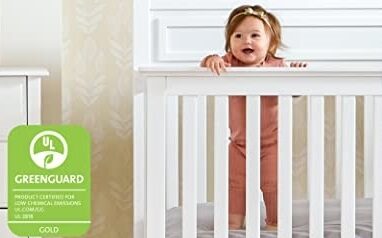
Safety Features
Both a regular crib and a mini crib are safe for your little one. However, standard cribs have passed through strict, standardized safety measures governed by the law. Thus, their safety can never be compromised. As for mini cribs, it is essential to check safety information given by their manufacturers.
Mini cribs and regular cribs are made from child-friendly materials and don’t release toxic emissions. They have smooth guardrails to avoid pricking your baby’s skin when they hold onto them. The guardrails also keep your baby from falling out.
Note that second-hand cribs and mini cribs do not have the same safety assurance as new ones.
Crib Mattress Sizes
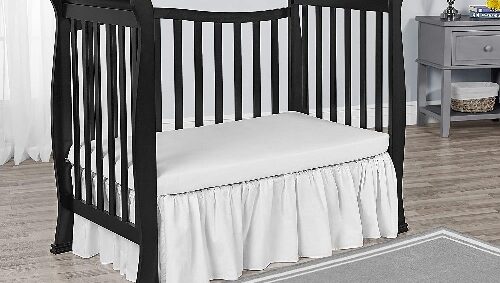
Standard crib and mini crib mattresses should not be too small for their respective cribs. The CPSC recommends a minimum of 271/4 x 511/4 inches for full-size crib mattresses.
Due to their lack of standardization, mini cribs should come with their mattresses.
Design Features
Both types of cribs have guardrails to prevent your baby from climbing out. The guardrails have an equal height of 20 inches from the bottom of the mattress support to the top.
A regular crib can come attached with a standard changing table, but a mini crib is smaller, so the changing table attached is petite. Many mini cribs have wheels, but most standard cribs lack wheels, for they are designed to remain in one position.
Convenience
Full-size cribs and mini cribs are very convenient for they can safely accommodate your baby from day one. However, the extent of their convenience depends on prevailing personal needs. For instance, mini cribs are ideal for newborns, nurseries with small spaces, room sharing, and travel. On the other hand, full-size cribs are suitable for weighty toddlers and big kids and are durable.
Mini Crib and Standard Cribs: What Do They Have in Common?
A mini crib and a regular crib are similar in many ways, such as:
- Both are the safest places for your baby to sleep in. They have guardrails and can accommodate your little one from the first day.
- Both a regular crib and a mini crib train your little one to sleep independently.
- Whether in a regular or mini crib, your baby sleeps without disturbance, unlike when you share your bed with them.
- Both are available in convertible designs or combos which give you more value for your money.
Mini Cribs and Standard Cribs: How Are They Different?
- Size- a regular crib is 28 x 52 inches, but mini cribs vary widely. The most common dimensions for a mini crib are 24 x 38 inches, but others can be 28 inches wide and 38 inches long.
- Mini crib mattresses and crib sheets are customized and rare to find, but regular crib mattresses and crib sheets are standardized and easy to find.
- Mini cribs are lighter and portable, but full-size cribs are heavy and non-portable. The heavyweight of a regular crib also makes it more stable than a mini crib.
- A regular crib can be the only bed your child uses up to adulthood if it converts into a full-size bed, but a mini crib can only last up to 50lbs if it is a convertible.
- A standard crib is more costly than a mini crib.
Crib Safety Measures
- Whether you’re using a crib or a mini crib, it is essential to take precautionary measures to keep your baby safe.
- Keep away pillows, blankets, and comforters since they can cause suffocation if your baby covers their face in them.
- Keep away large toys and stuffed animals since your baby can step on them to climb out.
- Always inspect your baby’s crib before use. If it’s new, cross-check for any damage, and follow the procedure on the manual for correct assembly.
- Position your baby’s crib away from direct sunlight and curtains or strings they may reach.
- Consider the position to place your baby’s crib before buying. For example, if your room isn’t large enough, you can pick a mini crib for your newborn and later buy a full-size crib as you transfer them to the nursery.
- When your child exceeds 35 inches, consider introducing them to a bed instead of using a crib. If your crib converts into a bed, then it’s time to transform it.
FAQs
- How small can a mini crib be?
Unlike a standard crib whose dimensions are regulated by the law, a mini crib can be 38 inches long and 24 inches wide or smaller, depending on your needs.
- How long can your little one use a mini crib?
Many babies outgrow the mini crib at 18 months or earlier, but others can go up to a maximum of two years.
- Can you use standard crib sheets on your mini crib?
No. standard size crib sheets will be loose on your mini crib, posing a suffocation risk to your baby.
- Is a mini crib better than a crib?
No. both are equally good, only their convenience differs.
Final Thoughts
A mini crib and standard crib are equally essential and safe for your baby to sleep. Mini cribs and full-size cribs have similar functions with a difference in size and price. You can choose a mini crib where space is limited or use a regular crib if you have more room. Full-size cribs are more costly than mini cribs, but the cost is compensated for their durability.

